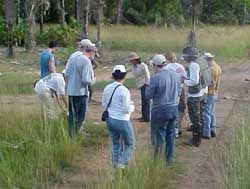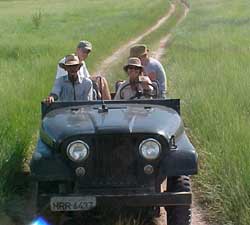 |






|
 |

 |
 |
 |
 |

Flora and Adam, in the foreground, listen as Ellen brings the group together to identify a track in the sand. |
 |
 |
 |
Highlights
The past two weeks have been full of memories and experiences that will stay with me forever. The experience as a whole has opened my eyes to what scientific research and nature are really like. I thought I was going to come down here to the Pantanal and see every animal up close and personal, when in fact there were only a couple animals, which I got to see. I am very disappointed that a tapir never crossed my path, yet I was fortunate enough to see a family of otters on two different occasions. Working hands-on with the scientists down here has to be my favorite thing from this experience because it made me realize how much I really love it. Even though it is demanding and doesn't always produce the results you want it to, in the long run it is all well worth it. Having a chance to connect with the scientists down here has also been a highlight of mine. They are all unique yet united in the way they love the environment so much. I am so glad that I was able to come down here and meet all the people and learn all the things I did.
Lyssa
Helen plans to do a long-term study of her otters — for 15 years! Two weeks out of 15 years seems like such a small contribution to such a huge project. But, on the last night Helen presented us with an abstract of all our accomplishments. Upon listing so many impressive facts and numbers of everything we've done in these memorable two weeks, I realized that everything I did on this project added to all that we did as a whole group. And those facts and numbers Helen so proudly read off that last night really have a huge impact on a very huge project. Every contribution, large or small, still adds to one overall goal, making each offering equally important whether it be two weeks or 15 years.
Phil
Although I've participated in many projects during the 2 weeks we've been here, I've felt the most accomplishment from working with Helen and Manuel. I spent roughly four of my days working in the lab, where I dissected fish, removing and cleaning all the bones and cartilage. These bones will be part of a database of all species of fish living in the Pantanal. Using this database, Helen can identify the individual bones she finds in the otter scat, and develop a better picture of what otters eat. There is an extraordinary amount of work that goes into each fish, and although it can be tedious at times, is well worth the effort.
Melissa
I spent two days scouring the riverbanks with Helen, searching for signs of otters. It seemed like we never saw anything. Each otter site previously marked was now flooded. We do all this work that doesn't seem like much, but in fact, it helps identify new things.
Nick
 |
 |
 |

Ellen is behind the wheel of the jeep while Baiano, a guide, Andrew and Lyssa ride. Sandy roads with deep ruts call for transportation by four-wheel drive vehicles. |
 |
 |
 |
Ever wonder how someone discovers enough information to write an encyclopedia article on an animal? I certainly didn't until this trip. I always took it for granted that all one had to do was to watch an animal to find out all one needs to know. I never realized just how difficult it was to even catch the slightest glimpse of some animals. I spent approximately 15 hours these past two weeks watching for otters, and the result was a 15 second sighting of a neotropical otter — all that work for the slightest amount of information. I have gained so much respect for the scientists that can do that type of demanding work every day, and I was very glad I had the chance to experience field research in its most real form.
Andrew
The devotion shown by the researchers in the Pantanal is incredible. For example, day after day otter researchers wake at 4:30 in the morning to sit among thousands of mosquitoes to wait for a mere glimpse of the otters. Why? Because this is their life, they leave their personal lives behind to gain greater knowledge. Some people do not understand why the devotion is present. Being in the field before sunrise with people who do this day after day makes one realize the significance of each day contributing to a larger picture of greater knowledge. The devotion shown by the researchers can only be understood once one understands the larger picture of each and every project. Working in the field on those projects allowed me to observe and experience their research efforts first hand. The two weeks I have been here has given me great respect for the researchers who make little contributions every day over many years to achieve their ultimate goal.
Adam
Louder and louder. First I heard the giant river otters vocalizing, then they came into sight swimming so fast they produced a wake like a motorboat. One stayed in the water and swam in front of the beach campsite. The other two slipped out of the water, bounced across the beach and then dove back into the water. All three darted away up the bay calling for more of their family to join. I wondered and waited, with my binoculars glued to my eyes, for their return. That was the day Helen danced.
Peter
My reality is so different from this place. My students are the children of boatman or fisherman. Even though they live in the Pantanal, they know nothing about it. They want to, but they do not have the means. The closest park to our school is a 10 kilometer walk. From all, I have learned working with the scientists here, I hope to pass on information and experiences that can help my students gain a new understanding and respect for the Pantanal. I hope this will build a good citizenship throughout the school.
Flora
I had no idea field research was so demanding. The commitment of these researchers and the physical challenge of the work were an eye-opening experience. As an environmental educator I have come to realize that the more I learn, the less I know. I have spent so much time on rivers fishing, yet I never realized what was there — at 43 I am just now coming to understand this. I will be able to use so much of what I have learned here in my teaching. I work with many people who were born and raised in the Pantanal and I will use track traps as a model for learning about the wildlife.
I rise at 4:15 to the hum of air conditioners and the buzz of mosquitoes. Manuel, Flora, Wanda, and I gather at a table already set with cold juice and a mobile breakfast for us to bring on our early morning trek to observe otters. We slather up with repellent, don our head nets and rubber boots, and join Dave for a quiet boat ride up the Rio Negro. I understand little as they converse in Portuguese, so I sit quietly as the sun rises and the silhouettes of herons and the squawks of kingfishers welcome us. The sky here is so big! We disembark near an oxbow, where we board two canoes and silently, (well, almost silently), paddle to an observation point across from the otter beach. The mosquitoes drive us all to put on more layers of Deet-covered clothing. Sweating is much better than thousands of bites. I fight sleep as we listen and look for the elusive otters. Each ripple caused by a water bug or jumping fish has the potential to be an otter, and our excitement ebbs and flows. Wanda turns to a sound she hears behind us, and we are treated to the quiet meandering of an anteater as it explores the ground by our beached canoes. It is a soft orange brown with vivid black markings, intent in its search we go unnoticed. Without stimulation I unwittingly fall asleep on watch, and awake to the grunting, scolding and screeching of otters. Our eyes are plastered to the place we hope they will emerge. But after a minute or so their calls retreat into the woods. We vigilantly sit our watch for another hour, with no sign of otters. I am grateful. I remember it all.
Susan
For more information, click on the Hudson School site.
Photos
courtesy of Earthwatch Institute
|
 |
 |
|
|
|
 |

